Big lips in fish are particularly interesting to observe in aquariums. In the wild, fleshy lips allow some carnivorous species to create a seal with the rocks and suck the prey out of the crevices. Big lips in some species also help scrape algae off the surfaces.
Whether you’re considering a big lip fish for your aquarium or are curious about a particular species that you saw, we’re here to provide you with all the details necessary.
Table of Contents
15 Fish with Big Lips
1. Gourami
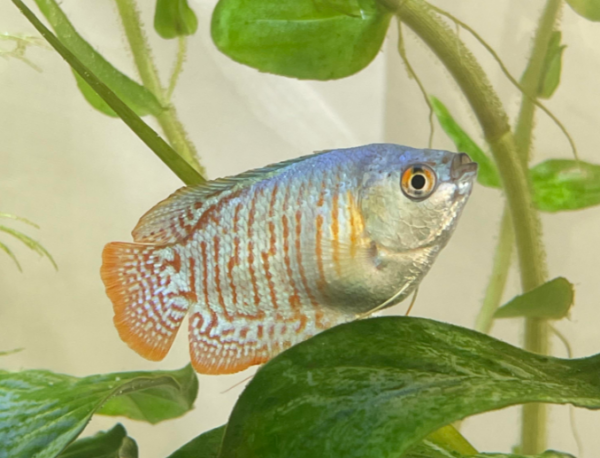
| Scientific Name: | Trichogaster trichopterus (Depends on the variety) |
| Family: | Osphronemidae |
| Care Level: | Easy to Moderate |
| Temperament: | Generally peaceful. Males can be territorial during mating season. |
| Color: | Various color patterns. Blue, Red, Green, Gold, Silver, etc. |
| Lifespan: | 4 to 6 years |
| Size: | 2 to 6 inches |
| Diet: | Omnivorous |
| Minimum Tank Size: | 20 gallons for a pair of average-sized Gouramis. Kissing Gouramis grow larger than average. |
| Temperature: | 72 to 82F (22 to 20C) |
| WaterConditions: | pH 6.0 to 7.5 Soft to moderate water hardness |
| Tank Mate Compatibility | Other peaceful community fish and Gouramis. |
Native to southwest Asia, extending from Pakistan to Indonesia, there are more than 90 species of Gouramis demonstrating a wide range of characteristics and colors.
Varieties of the Gouramis include:
- Blue Gourami
- Honey Gourami
- Dwarf Gourami
- Kissing Gourami (Very fleshy lips)
- Pearl Gourami
- And many more
Adapted to breathe air directly from the air, Gouramis are freshwater labyrinth fish that come in stunning colors and intricate patterns. In the wild, they mostly live in low-oxygenated swamps, where this adaptation is particularly effective. Male gouramis, similar to betta fish, make bubble nests to house their eggs and guard them religiously.
2. Koi
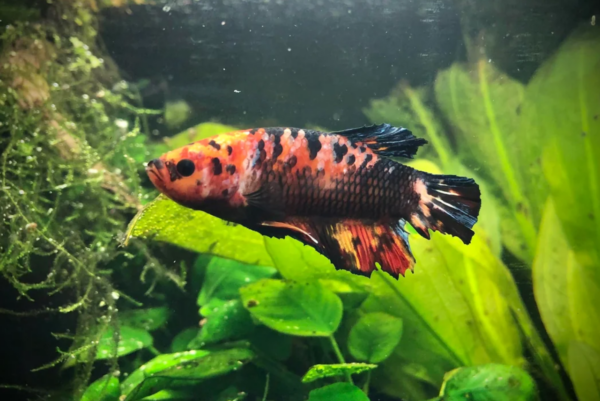
| Scientific Name: | Cyprinus rubrofuscus |
| Family: | Cyprinidae |
| Care Level: | Peaceful. Can be aggressive during feeding frenzy. |
| Temperament: | Moderate to High |
| Color: | Various color patterns and combinations. |
| Lifespan: | 20 to 30 years |
| Size: | 2 to 4 feet |
| Diet: | Omnivorous |
| Minimum Tank Size: | Outdoor ponds |
| Temperature: | 59 to 77F (15 – 25C) |
| WaterConditions: | pH 7.0 to 8.0 Soft to moderate hardness |
| Tank Mate Compatibility | Other peaceful fish species |
A popular choice for decorative ponds, Koi fish are a derivative of the common carp that first originated in China in the 16th century. However, the breeders in Japan are the ones who develop the modern variety of colorful Koi with big lips.
Varieties of Koi include:
- Kohaku
- Taisho Sanshoku
- Showa Sanshoku
- Doitsu-goi
- Shubunkin
In the winter, you may see the Koi go through partial hibernation when their metabolism takes a nosedive. They also don’t eat much during this time. Koi also are notorious divers. They can leap several feet out of the water to the delight of predatory birds. Make sure to cover your pond, especially during the breeding season.
Also Read: How Long Do Koi Fish Live?
3. Pacu
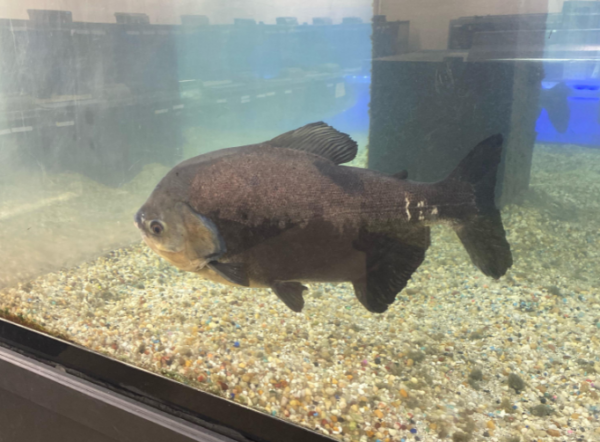
| Scientific Name: | Piaractus brachypomus |
| Family: | Characidae |
| Care Level: | Intermediate to advanced |
| Temperament: | Generally peaceful, but can become aggressive in confined spaces. |
| Color: | Silver or gray with red tint on fins and tail. |
| Lifespan: | More than 10 years |
| Size: | 2-3 feet |
| Diet: | Omnivorous |
| Minimum Tank Size: | Outdoor ponds with several hundred gallons |
| Temperature: | 75 to 82F (24-28C) |
| WaterConditions: | pH: 6.0 to 7.5 Moderately hard water |
| Tank Mate Compatibility | Larger peaceful fish |
Native to the Amazon basin in South America, Pacu are considered food fish all around the globe. However, that didn’t diminish Pacu’s popularity as an ornamental fish. Pacu’s big lips house their impressive teeth, which closely resemble us humans and allow them to consume fallen fruits, nuts, and small fish.
Varieties of Pacus include:
- Black Pacu (Largest variety)
- Red-Bellied Pacu
- Silver Pacu
Pacus also have a small opening on top of their head called a spiracle that allows them to take oxygen directly from the water’s surface. Despite being a member of the piranha family, Pacu has a high affinity towards fruits. They also are exceptional jumpers—jumping out of boats and even over waterfalls.
Also Read: Amazon Sword Care Guide – Carpet, Floating, Propagation
4. Pink-Streaked Wrasse
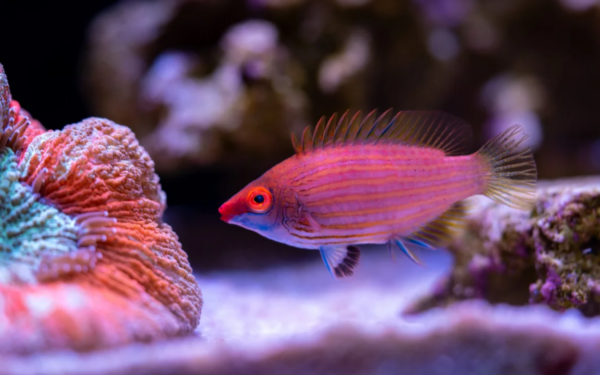
| Scientific Name: | Pseudocheilinops ataenia |
| Family: | Labridae |
| Care Level: | Moderate |
| Temperament: | Peaceful. Males can be territorial. |
| Color: | Pinkish bodies with blue stripes running horizontally across their body. |
| Lifespan: | 5-7 years |
| Size: | 4-5 inches |
| Diet: | Carnivorous. Feeds on small crustaceans and worms. |
| Minimum Tank Size: | 30 gallons for a small group. |
| Temperature: | 75 to 82F(24-28C) |
| WaterConditions: | pH: 8.1 to 8.4 Moderately hard water |
| Tank Mate Compatibility | Reef-safe. Compatible with other peaceful species. |
Our first saltwater mention, Pink-Streaked Wrasse is native to the Indo-Pacific region, including Indonesia, Japan, Philippines, and Australia. They’re mostly found in coral reefs and have pointed thick lips to reach into small crevices and suck their prey out.
There are no known varieties of Pink-Streaked Wrasse, but they have several adaptations allowing them to survive in the coral reefs. This includes their impressive eyesight and intelligence. Similar to clown fish, Wrasses also are sequential hermaphrodites, born females and eventually turning into males when necessary.
5. Piranha
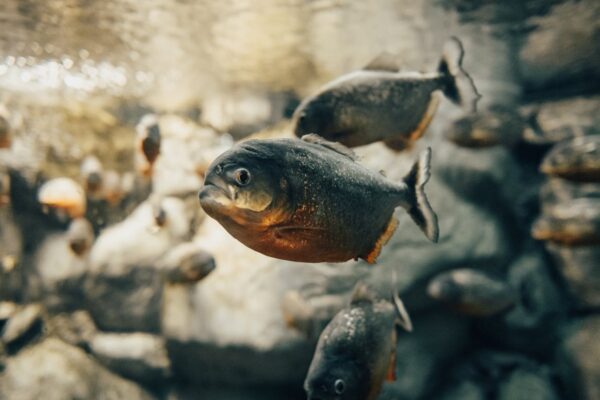
| Scientific Name: | Pygocentrus nattereri |
| Family: | Serrasalmidae |
| Care Level: | Advanced |
| Temperament: | Highly predatory and aggressive |
| Color: | Silver with reddish-orange undersides. |
| Lifespan: | 10 years |
| Size: | 6 to 12 inches |
| Diet: | Carnivorous |
| Minimum Tank Size: | 75 gallons |
| Temperature: | 75-82F (24-28C). |
| WaterConditions: | pH: 6.0 to 7.5 Soft to moderate water hardness |
| Tank Mate Compatibility | Other Piranhas |
Navigating the freshwater environments across South America, the Piranha family is estimated to be around 60 million years old. Once they were a much larger species, instigating terror with their triangular teeth and powerful jaws, which hasn’t changed much over the years. However, they aren’t always bloodthirsty and rarely attack humans.
Varieties of Piranha includes:
- Red-Bellied Piranha
- Black Piranha
- Wimpel Piranha
- Vampire Piranha
Piranhas have a compressed body, supercharged by excellent eyesight and blood detection, allowing them to dart quickly and shear their prey. Some members of the Piranha family, however, are more interested in fruits and nuts than flesh and bones.
Also Read: Silver Dollar Care Guide, Breeding, Tank Size, & Diseases
6. Napoleon Fish
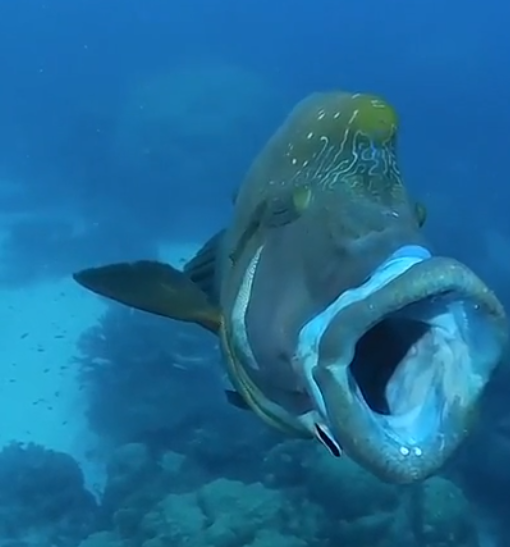
| Scientific Name: | Cheilinus undulatus |
| Family: | Labridae |
| Care Level: | Advanced |
| Temperament: | Peaceful and territorial |
| Color: | Blue with black spots. Have a prominent hump on their head. |
| Lifespan: | 10-15 years in captivity |
| Size: | 3-4 feet |
| Diet: | Carnivorous. Feeds on invertebrates and small fish. |
| Minimum Tank Size: | Large ponds with gallons of water |
| Temperature: | 75-82F (24-28C). |
| WaterConditions: | pH: 8.1 to 8.4 Moderately hard water |
| Tank Mate Compatibility | Other predatory fish in large tanks |
The Napoleon Fish or the Napoleon Wrasse is native to the Indo-Pacific region, including the Red Sea, East Africa, Japan, and the Indo-Australian Archipelago. Popular in many parts of the world in food and aquarium trade, this critically endangered saltwater fish can grow up to 7 feet in the wild. However, they struggle to survive in the captive waters without proper care.
The two primary varieties of Napoleon Fish are:
- The Maori Wrasse (Smaller and has a more rounded hump)
- The Humphead Wrasse (Larger, have a more prominent hump, also called humphead wrasse)
Napoleon fish are extremely large and powerful, cracking open hard-shelled mollusks, crustaceans, and even sea urchins with their teeth hidden behind fleshy lips. However, that doesn’t justify their unique coloration and the ability to change sex throughout their lives. They also have pretty impressive memories, often recognizing divers and tools.
Also Read: Foxface Fish: Complete Guide To Care, Breedings, Tank Size, And Disease
7. Flowerhorn Cichlid
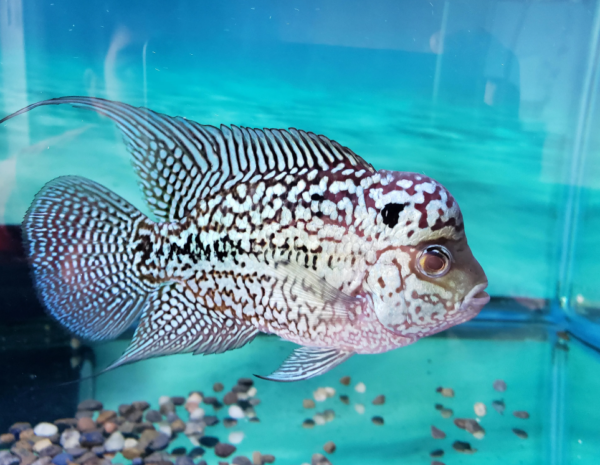
| Scientific Name: | Hybrids derived from Amphilophus citrinellus and Vieja synspila |
| Family: | Cichlidae |
| Care Level: | Moderate |
| Temperament: | Aggressive and territorial |
| Color: | Vibrant colors and patterns with a hump on their forehead. |
| Lifespan: | 10 to 12 years |
| Size: | 12 inches |
| Diet: | Omnivorous diet |
| Minimum Tank Size: | 75 gallons or more for a single adult Flowerhorn |
| Temperature: | 78-82F (25-28C) |
| WaterConditions: | pH: 6.5 to 7.5 Moderately hard water |
| Tank Mate Compatibility | Best kept alone |
Created by humans exclusively as an ornamental fish, Flowerhorns are the result of cross-breeding among various cichlids. Breeders have continued to refine the Flowerhorn’s appearance, resulting in the amazing diversity seen today.
The popular varieties of Flowerhorn include:
- Zhen Zhu
- Kamfa
- Golden Monkey
The most distinctive feature of the Flowerhorn is the large Kok that develops on its head and the big lips. Breeders favor a prominent, smooth kok, and some believe it signifies good luck and prosperity. They also are pretty intelligent and curious creatures, always interacting with their owners and begging for food.
8. Common Pleco
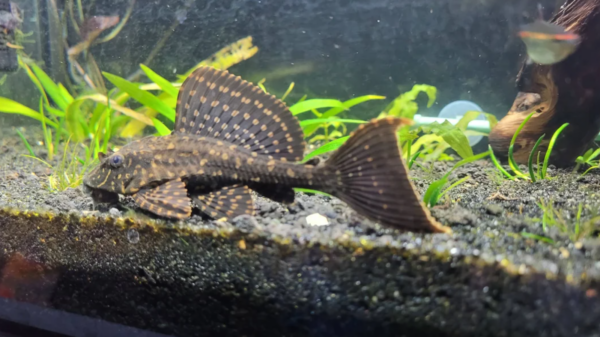
| Scientific Name: | Hypostomus plecostomus |
| Family: | Loricariidae |
| Care Level: | Easy to moderate |
| Temperament: | Peaceful. Can be aggressive towards other bottom-dwelling species |
| Color: | Dark brown or black |
| Lifespan: | 10 to 15 years |
| Size: | 12 to 24 inches |
| Diet: | Omnivorous |
| Minimum Tank Size: | 75 gallons for a single adult specimen |
| Temperature: | 72-82F (22-28C) |
| WaterConditions: | pH: 6.5 to 7.5 Soft to moderate water hardness |
| Tank Mate Compatibility | Compatible with a wide range of tank mates |
Common pleco is one of the most distinguishable freshwater aquarium fish, probably second only to goldfish. They’re native to the Amazon and Orinoco River basins in South America, but are found all around the globe. In the wild, they inhabit slow-moving, murky water where a lot of algae and driftwood are present.
Some other pleco varieties include:
- Zebra pleco
- Leopard pleco
- Sailfin pleco
- Royal pleco
These nocturnal fish are equipped with a suckermouth for their benthic mobility and constantly growing rasping teeth for scraping off algae from driftwood and decorations. Their digestive system also extracts nutrition from cellulose derived from the driftwood. For protection, bony plate armors cover their whole body. However, common plecos are pretty invasive and are often found in the wild, released by hobbyists, growing bigger at the expense of the unfamiliar local ecology.
Also Read: 15 Types Of Plecos For Your Tank
9. Sweetlips Fish
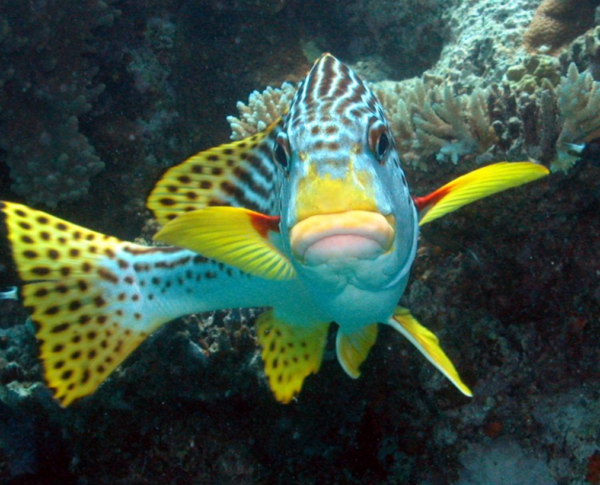
| Scientific Name: | Plectorhinchus spp. |
| Family: | Haemulidae |
| Care Level: | Moderate |
| Temperament: | Peaceful. Territorial towards other sweetlips. |
| Color: | Shades of yellow, orange, brown, and white with spots and blotches. |
| Lifespan: | 8-15 years, depending on the species |
| Size: | 8 to 24 inches, depending on the species |
| Diet: | Omnivorous |
| Minimum Tank Size: | At least 100 gallons for most sweetlip species |
| Temperature: | 75-82F (24-28C) |
| WaterConditions: | pH: 8.1 to 8.4 Moderately hard water |
| Tank Mate Compatibility | Other peaceful species |
Sweetlips fish are a large family (Haemulidae) of perch-like fishes with over 130 species. They are found in tropical and subtropical waters around the world, including the Atlantic, Indian, Pacific, and Mediterranean Oceans. They’re particularly abundant in the Indo-Pacific region.
The most popular Sweetlips varieties include:
- Blueline sweetlips
- Crimson sweetlips
- Yellowstripe sweetlips
- Freckled sweetlips
- Rusty sweetlips
- And many more
True to their name, sweetlips have a compressed body with big lips to suck up small invertebrates from the substrate. Their mouths can extend outwards to reach food in crevices. They also have excellent eyesight and a good sense of smell to identify and avoid predators. Some sweetlips can produce sounds to communicate among themselves and startle predators.
Also Read: 10 Reasons Why Your Fish Keep Dying
10. Clown Loach
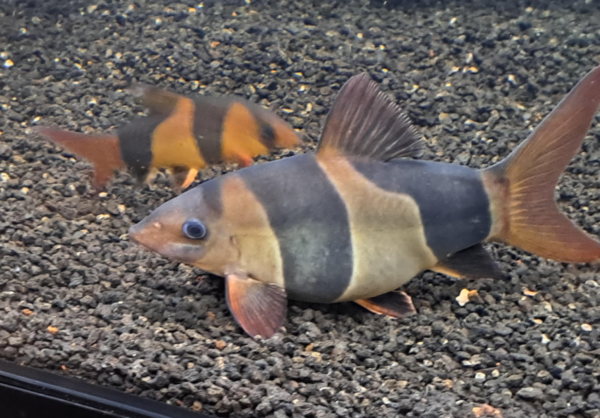
| Scientific Name: | Chromobotia macracanthus |
| Family: | Botiidae |
| Care Level: | Moderate |
| Temperament: | Peaceful and social |
| Color: | Vibrant coloration with black and orange stripes |
| Lifespan: | 10 years with proper care |
| Size: | 8 to 12 inches |
| Diet: | Omnivorous |
| Minimum Tank Size: | 75 gallons for a small group |
| Temperature: | 75-82F (24-28C) |
| WaterConditions: | pH: 6.5 to 7.5 Soft to moderately soft water |
| Tank Mate Compatibility | Compatible with a wide variety of fishes |
Clown Loaches are native to Southeast Asia, particularly in the murky, slow-moving waters of Borneo, Sumatra, Thailand, and the Malay Peninsula. These fatty-lip fish are adaptable to navigate through tight spots under rocks and driftwood. The barbells around their mouth are used to taste and scavenge food.
Common varieties of Clown Loaches include:
- Golden clown loach
- Albino clown loach
- Chocolate clown loach
Although clown loaches can grow up to 12 inches, they seldom grow beyond 5 inches in length. These schooling fish do best in groups of 5 or more. They can erect sharp spines hidden under their skin to deter predators.
Also Read: How To Take Proper Care Of Tropical Fish Babies (Fry)
11. Clown Triggerfish
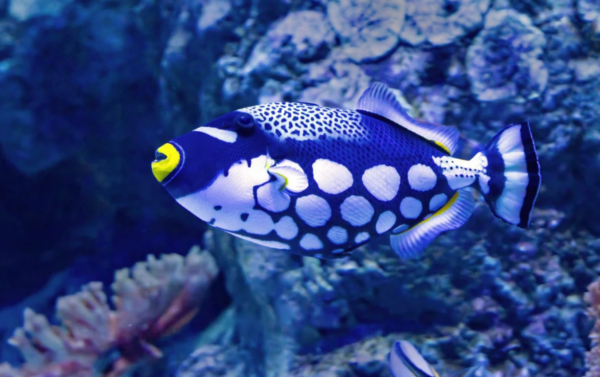
| Scientific Name: | Balistoides conspicillum |
| Family: | Balistidae |
| Care Level: | Moderate to advanced |
| Temperament: | Aggressive and territorial |
| Color: | Various colors and unique patterns, spots, or patches. |
| Lifespan: | 10 years |
| Size: | 10-15 inches |
| Diet: | Omnivorous diet |
| Minimum Tank Size: | 100 gallons or more |
| Temperature: | 75-82F (24-28C) |
| WaterConditions: | pH: 8.1 to 8.4 Moderately hard water |
| Tank Mate Compatibility | Best kept alone |
The Clown Triggerfish, native to the warm tropical waters of the Indo-Pacific region, from the Red Sea to South Africa and across to French Polynesia, commands attention with its vibrant colors and distinctive markings. They’re revered in both the culinary world and the aquarium trade.
Notable varieties of Clown Triggerfish include:
- Blue Throat Triggerfish
- Pink Tail Triggerfish
- Red-tailed Triggerfish
The most interesting adaptation of Clown Triggerfish is their use of strong dorsal fins. These fins can be locked into crevices and holes to allow the fish to wedge itself tightly—deterring predators. They also have powerful jaws to crush hard-shelled crustaceans and sea urchins.
Also Read: Niger Triggerfish: Tank Setup, Caring, Feeding And Breeding Guide
12. Humpback Red Snapper
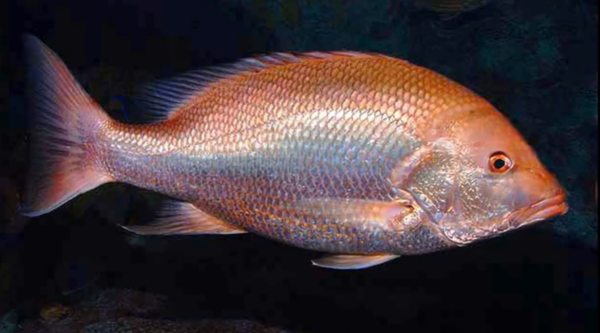
| Scientific Name: | Lutjanus gibbus |
| Family: | Lutjanidae |
| Care Level: | Moderate |
| Temperament: | Peaceful. But it can be territorial. |
| Color: | Reddish-pink body with distinct yellow or white stripes running along its sides. |
| Lifespan: | 10-15 years |
| Size: | 16-20 inches |
| Diet: | Carnivorous. Feeds on small fish and crustaceans. |
| Minimum Tank Size: | 100 gallons or more |
| Temperature: | 75-82F (24-28C) |
| WaterConditions: | pH: 8.1 to 8.4 Moderately hard water |
| Tank Mate Compatibility | Species-specific tank with other carnivorous tank mates. |
Inhabiting the warm waters of the Indo-Pacific, Humpback Red Snappers are found across the Red Sea, Philippines, and all the way to Japan and Australia. Thanks to their several adaptations, Snappers thrive in reef environments. In addition to their coloration, the hump on the adult males is used in displaying dominance.
Depending on the region, some color variations may be observed in Humpback Red Snappers, but there are no technical varieties present. However, the variation in colors may also be attributed to Snappers’ capability of rapidly changing color to blend with the surroundings. They can also be seen working together to herd prey into traps and stay safe from predators.
13. Bluespine Unicorn Fish
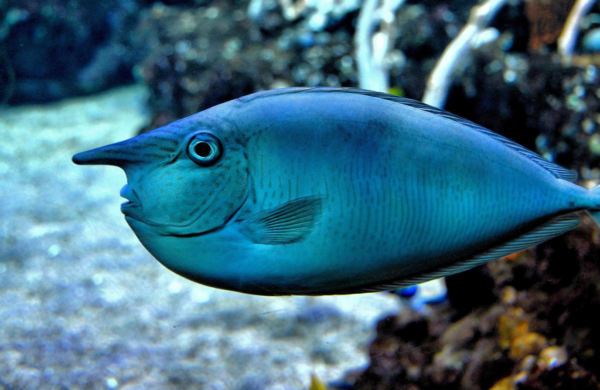
| Scientific Name: | Naso unicornis |
| Family: | Acanthuridae |
| Care Level: | Moderate |
| Temperament: | Peaceful. Territorial towards its kind. |
| Color: | Powder blue body with yellow snout and blue spines extending from the tail. |
| Lifespan: | 10-15 years |
| Size: | 16-20 inches |
| Diet: | Herbivorous |
| Minimum Tank Size: | 125 gallons |
| Temperature: | 72-78F (22-26C) |
| WaterConditions: | pH: 8.1 to 8.4 Moderately hard water |
| Tank Mate Compatibility | Other larger tank mates |
The Bluespine Unicornfish is a captivating fish inhabiting the Indo-Pacific coral reefs. With its vibrant blue markings and distinctive shape, it’s a true underwater marvel probing crevices and consuming algae with its pointed protruding horn. They can also rapidly change color to a degree when threatened.
There are no known variations of Bluespine Unicornfish present, but a few close relatives, namely Yellow Unicornfish and the Orangespine Unicornfish, can be observed in similar environments. Unicorn Fishes secrete a mucus cocoon around themselves while they sleep to deter predators and parasites.
14. Giant Grouper
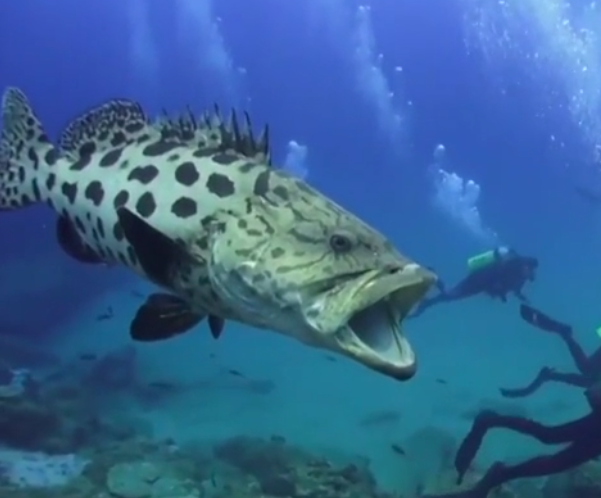
| Scientific Name: | Epinephelus lanceolatus |
| Family: | Serranidae |
| Care Level: | Advanced |
| Temperament: | Generally peaceful, but can become territorial with age |
| Color: | Brown to gray with blotches and spots. |
| Lifespan: | 30-35 years |
| Size: | 5-6 feet |
| Diet: | Carnivorous. Feeds on smaller fish, squids, and crustaceans. |
| Minimum Tank Size: | Exceptionally large outdoor setups |
| Temperature: | 72-82F (22-28C) |
| WaterConditions: | pH: 8.1 to 8.4 Moderate water hardness |
| Tank Mate Compatibility | Best kept alone with other large fish. |
Gentle giants of the reef, the Giant Grouper are from the warm, tropical waters of the Indo-Pacific, inhabiting coral reefs and rocky areas from the Red Sea to Southeast Asia and beyond. Groupers are apex ambushers who, thanks to their large bodies and particular adaptations, dominate their environment.
These reef adaptations include sharp eyesight, a strong sense of smell, big lips, and the ability to change sex. While there isn’t a vast array of varieties within the Giant Grouper species, there are some regional variations in color patterns. Despite their size, Groupers are generally quite docile towards divers, earning them the nickname “gentle giants”.
Also Read: South American Vs African Cichlids: Pros And Cons
15. Marine Angelfish
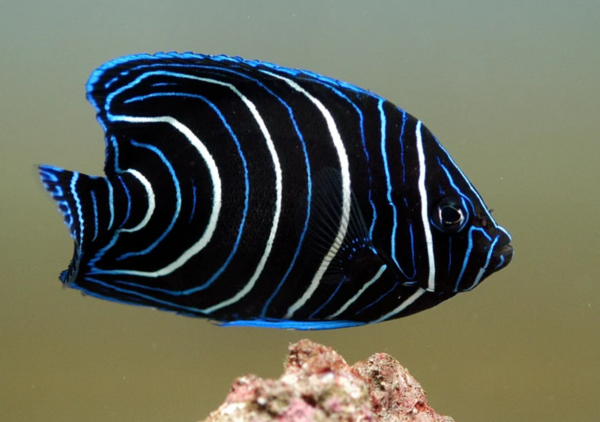
| Scientific Name: | Pomacanthus imperator |
| Family: | Pomacanthidae |
| Care Level: | Moderate to advanced |
| Temperament: | Territorial and aggressive |
| Color: | Vibrant blue, yellow, orange, red, and white with intricate patterns and markings. |
| Lifespan: | 7-10 years |
| Size: | 10-12 inches |
| Diet: | Omnivorous |
| Minimum Tank Size: | 75-100 gallons for a pair |
| Temperature: | 72-78F (22-26C) |
| WaterConditions: | pH: 8.1 to 8.4 Moderately hard water |
| Tank Mate Compatibility | Compatible with peaceful similar-sized species |
Native to the Indo-Pacific and Atlantic Ocean, Marine Angelfish is a dazzling creature living in the warm water coral reefs. Their flat, oval body allows them to navigate the crevices and evade predators when necessary. They also have keen eyesight and a lateral line system to detect vibrations in the water.
Over 80 stunning Marine Angelfish species are present with unique colors and markings. Most popular of them include:
- Regal angelfish
- Flame angelfish
- French angelfish
Some angelfish species have venomous spines hidden under their bodies for defense purposes. Many angelfish species also are sequential hermaphrodites, starting their lives as females and later turning into males when necessary.
Also Read: White Mold In Aquarium, What Are They?
The Bottom Line
The fascinating world of fish with big lips offers a glimpse into the diversity and marvels of aquatic life. Through stunning photos and intriguing facts, we’ve explored just a fraction of the beauty and uniqueness found beneath the waves. Explore further and let us know about other big lip fish that you find interesting.
